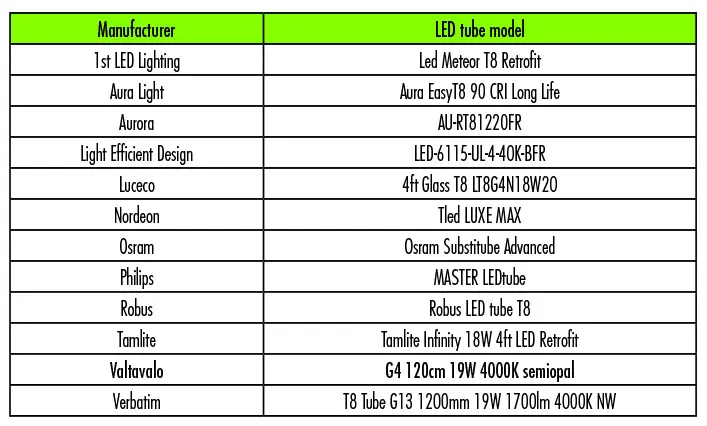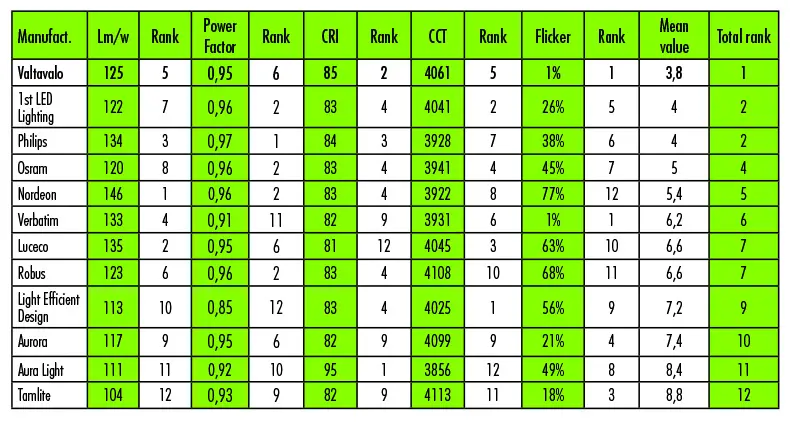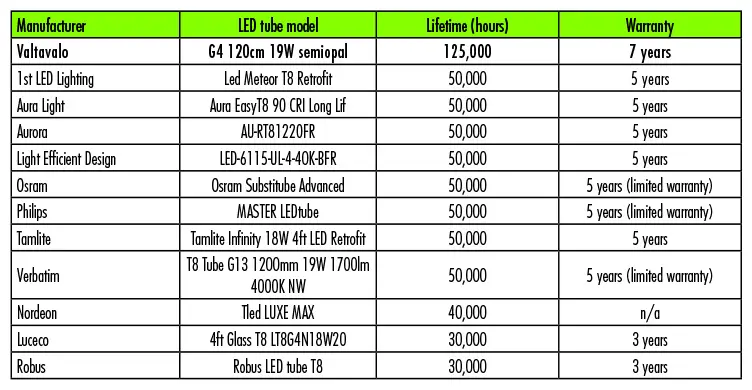The English LuxReview periodically carries out tests on lighting products, the latest being a test of LED tubes. The tests were carried out at the LIA laboratory in Telford – with over 30 years of experience in the field, it is the leading laboratory specialising in lighting product testing in Europe.
The test report published on 23 may 2016 was written by the magazine’s technical editor, Alan Tulla.
LuxReview tests
The latest models from a total of 12 major LED tube brands were tested during April and May 2016. Valtavalo sent two of their 120cm 19W 4000K G4 LED tubes with semiopal covers, which is the company’s newest product, launched in February 2016.
The table below shows the tubes that were included in the test. Please note that the listing is made by Valtavalo based on the information given on the product review. The exact models have not been confirmed and they are subject to change
In the laboratory, the luminous efficacy (lm/w), colour rendering (CRI), colour temperature (CCT), power factor and flicker percentage of the tubes were tested.
The assessment highlighted four products that on the basis of the tests and the sample tubes, LuxReview recommends. The same article reminds us, however, that most manufacturers have products for different needs and the products could be assessed on e.g. purchase price, light output, colour rendering or absence of flicker, depending on the requirements.
It is often the case that when a certain feature is concentrated on in the design of an LED tube, it often weakens some other feature. For example, from Valtavalo’s product range it is possible to find an LED tube with a high colour rendering index (CRI >90), but its luminous efficacy (lm/w) is lower than that found in a tube with a CRI of >80.
Lux Review recommends tubes on the basis of three measure values: luminous efficacy, absence of flicker and colour rendering. Valtavalo’s G4 LED tube is one of the tubes recommended by LuxReview.
The otherwise comprehensive article did lack a summary table for all five values that were measured, so we made it ourselves. We compiled the measured values for the tested tubes, put them in order and calculated the average for the positions. This data can be seen in the table below.
Regarding the measured values:
* lm/w = Luminous efficacy
* Power Factor Gives the active power to apparent power ratio in AC loads.
* CRI = Colour rendering index. Light with a CRI of over 80 is perceived as being quite natural. Among the tested tubes, there were both higher and lower colour rendering tubes, which somewhat distorted the results.
* Flicker = Flicker can be expressed as a percentage and using the flicker index. There is no one commonly agreed standard for what percentage of flicker is acceptable. We can say, however, that the lower the figure, the less flicker there is and the less likely one is to notice that flicker. Generally speaking, we can say that the flicker percentage of a fluorescent tube or a typical LED tube is around 30. The average of the flicker values measured in this test was 38.7%.
* CCT = Correlated colour temperature. CCT gives us the hue of the light. In the scoring, a deviation from the stated value (4000K) has been counted.
Significant differences in manufacturers’ stated lifespans and warranty times
Despite the fact that the test concentrated on easily measurable values and the main competitive edges of Valtavalo’s LED tubes, i.e. their high quality and longest lifespan on the market, were not taken into account in the review, the ranking that the G4 LED tube attained is still, on the whole, excellent.
If we include in the comparison the lifespans and warranty periods given by manufacturers, the G4 LED tube’s lead becomes even greater. The G4’s lifespan of 125,000 hours as stated by Valtavalo and seven-year warranty are based on the product’s automated manufacture and mechanical design, as well as its high-quality components. The power source of the G4 LED tube is isolated and all its components have been designed to last to give the product a long lifespan. It is worthwhile to familiarise oneself with the warranty terms of various LED tube manufacturers – sometimes product warranties are limited, for example, with maximum daily usage hours.
Valtavalo’s LED tubes are made in accordance with the EN62776 standard. The standard approved on 11 December 2014 makes it possible to manufacture LED tubes that are compatible with conventional T8 fluorescent tubes. Moreover, it defines the characteristics required of LED tubes to make them mutually compatible. Alan Tulla, the author of the product review, also reminds us when selecting an LED tube to check whether it is made according to standard. The article recommends inserting an LED tube into a lighting fixture taking a fluorescent tube only when it entails no more than changing the tube and the starter. Furthermore, the article recommends to avoid rewiring lighting fixtures to make them suitable for LED tubes.
Valtavalo’s position on this matter is that if the modifications are done by a qualified electrician, then there should be no issues regarding safety. After the modifications, the fixture is clearly marked with a fixture modification sticker, available from Valtavalo, with the contact details of the person who modified the fixture. An old lighting body then only acts as a support and power feed for the tube and the responsibility for ensuring that the new fixture is safe and meets requirements moves to Valtavalo. As the lighting fixture is not being launched on the market (i.e. resold), it does not need a new CE marking after the modification work.
The table below lists the lifespans and warranty periods given by the manufacturers for the tested LED tubes.
Temperature rises halve lifespans
The article highlights the effect of temperature on LED tube lifespan and there is a reminder of the rule of thumb for electronic equipment: for every 10-degree increase in temperature (above room temperature), the actual lifetime decreases by 50 per cent. Near the ceiling, the temperature can be easily 10 degrees higher than at the level of use. In the same way, inserting the tube into a closed light fixture raises its temperature further. Usually, lifespan is given at room temperature, but in reality it could be much lower than stated.
In practice, this means that the lifetime of an LED tube inside a housing is no longer 40,000 hours as promised, but 20,000 hours. If the lamp is fixed high up on the ceiling where the air is ten degrees above room temperature due to stratification, LED tubes hardly even have the same lifetime as conventional fluorescent tubes.
This really should be taken into consideration when selecting a lighting solution – only by investing in industrial-grade LED tubes with a lifetime of 125,000 hours can you be sure that the tube will withstand demanding conditions and you ensure that you actually save money during the tubes’ lifetime. The G4 LED tube’s life cycle costs are among the lowest in the market.






